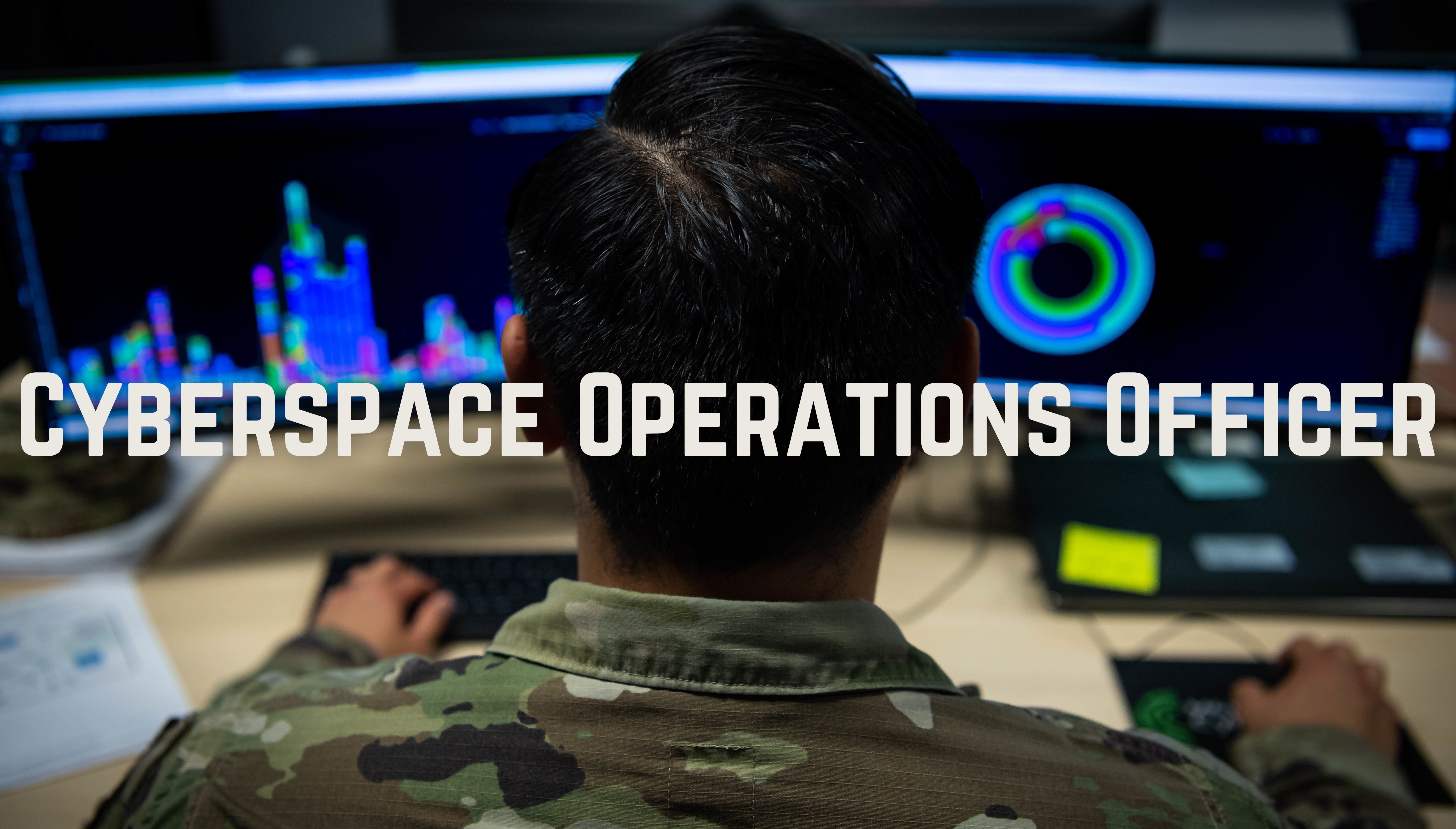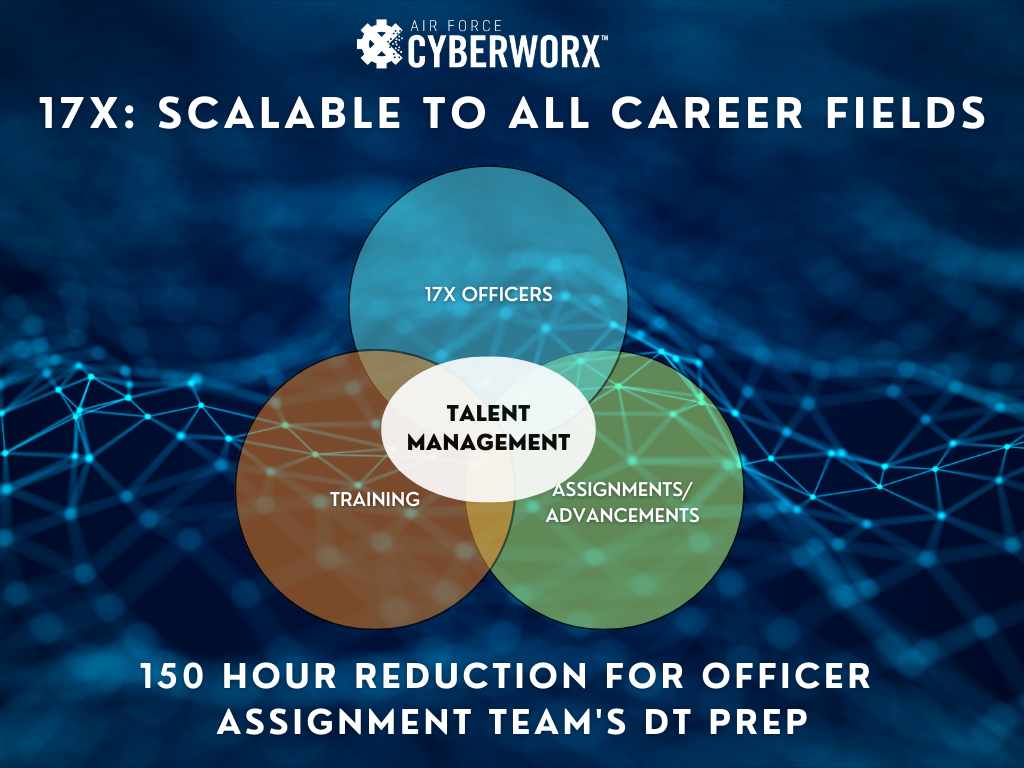17X: The Cyber Career Field

Identifying top talent for Air Force senior leadership should be a well-thought-out process with significant rigor, which is precisely what the heads of the cyber career field have chartered AF CyberWorx to develop. Yet the officer assignment teams still employ an overly manual process, with little standardization—aggregating data from multiple spreadsheets, which requires hundreds of hours of preparation.
A recent article published by Defense One has reported that a staggering 25 percent of the DoD cyber positions are currently vacant. This alarming statistic highlights the urgent need for effective intervention to secure top talent within the cyber career field and the reason Brig Gen Blackwell cited this as her number one priority when we met with her earlier this summer.
What would improve this process and optimize senior officer selections? Enter the innovation hub Air Force CyberWorx and our team of researchers, designers, and problem solvers.
AF CyberWorx’s collaboration with the 17X Development Team (DT) originated from a previous project, requested by Brigadier General Heather Blackwell, that examined the 17X cyber career field’s current state and needs—from initial skills training to senior positions such as the ACC A6.
Following months of research and interviews with 17X officers, our team identified several courses of action to modernize 17X cyber talent management, including the need for efficacy and efficiency improvements to the current DT process. With our previous research in mind, the AF CyberWorx team tackled the following problem statement:
“How might a system aggregate and present 17X billet, training, and education data to enable DTs to make the best 17X talent management decisions more efficiently?”
The Challenge at First Glance
At first glance, this problem may seem straightforward, but the interdependencies and elements involved in supporting the DT process were more complex than anticipated. Not only is the DT process a mostly internal “secret” to protect its integrity, but it also has significantly different criteria from one DT to the next—particularly when the DT board leadership turns over.
What would best solve this problem statement? A combination of human-centered design, user experience research, and a few passionate software engineers.
The problem statement above focused our team’s approach onto Air Force cyber career talent management. We leveraged several methods to uncover the core DT process, the current succession-planning process, and how the boards themselves are administered.
By properly scoping the project, our team provided key deliverables for Air Combat Command (ACC) to decrease the time burden on the Officer Assignment Teams (OATs) and the DT board itself. Our deliverables centered on platform-agnostic design criteria to guide requirements for any DT board system.
In a parallel endeavor, our team researched and received demonstrations of seven platforms that talent management professionals already use, ensuring we could accurately assess what each platform contributed to the process and recommend a primary and two alternate platform options.
Our team also recommended a series of DT process changes and partnered with Project Arc software engineers to create a fully-functioning minimum viable product (MVP). In our final report, the AF CyberWorx team highlighted these outputs and illuminated a path forward.
Research and Design Process
AF CyberWorx’s output from the previous 17X talent management project prompted further research, specifically through the DT lens.
We researched the 17X DT process, the key players involved in the DT process, and industry succession-planning best practices. After our research created a baseline, our team conducted user interviews with key stakeholders.
A few of the questions we asked the participants:
In this initial phase, 12 in-depth interviews with previous 17X OAT members, Career Field Managers (CFM), Talent Marketplace experts, a 6X career field expert, and a MAJCOM civilian talent management representative filled in the knowledge gaps and gave us a clearer picture of the 17X DT process before exploring recommended changes. Condensing these findings into a full process flow revealed opportunities as well as barriers.
Understanding the current process baselined the process flow. Next, we set our sights on crafting design criteria for a platform to improve this process.
Design criteria for a system must be platform-agnostic to maximize the possibilities, but identifying a platform that can most closely meet the needs was also important to provide context. Our team scheduled demos of the current systems and annotated pros and cons of each system to develop the design criteria.
Primary Platform Recommendation: Envision
The Envision platform provided higher-fidelity data and access to all major Air Force systems of record that set it apart from the other options. Knowing this, our team built an initial MVP using Envision. With design criteria and a viable platform in place for the initial development work, we then focused on the process changes needed to create an ideal state of 17X DT boards.
Creating an ideal state of anything can feel like an overwhelming task, but in the case of the 17X DT boards, our team felt a few specific changes could significantly improve the process. The main criteria we identified were the points within the process where non-standard inputs are in play, or where more information is needed to improve decision-making.

We aimed two of our recommendations at the needs of the billet owners—information the OAT requires in order to build the DT board slate. These two recommendations: provide more robust requirements for each rotating billet, and limit by-name requests to the early stage of the process to avoid cascading corrections later.
Along with the need for more detailed information from billet owners, our team also identified a need for officer candidates to better provide a complete account of their knowledge, skills, and abilities. With better information for both the turning billets and the candidates themselves, the process will produce better matches.
Throw in another primary recommendation to provide a score for each billet-officer match, and you have an optimized process to support the DT board.
Our Minimum Viable Product (MVP)
AF CyberWorx and developer-engineers from Project Arc created an MVP to illustrate the realm of possibility for a DT board platform. Beginning with the work of a single Envision subject matter expert (SME), Capt Adam Bordeau, this MVP quickly showed that a system could aggregate the majority of officer and billet information instantly, while also providing a graphical user interface (GUI) that board members could use to slate candidates.
After demonstrating this initial prototype to Brig Gen Blackwell, our team was authorized to continue this MVP effort alongside the original. Two Project Arc members, 1st Lt Richard Razon, and Capt Brian Guerrero, refined the idea into a functional MVP using real system data.
Our team reviewed the design criteria with Project Arc, and the engineer-developers transformed the DT’s Excel sheets into purpose-built templates. Then we conducted user testing with the OAT, using feedback from that session to iterate the MVP.
Additional Development
A blueprint is only as good as our ability to follow through to completion—which is why the AF CyberWorx team also provided a series of options for continued development and sustainment of a 17X DT board system. The clear choice our team identified for continued MVP development was Envision.
The platform is uniquely positioned to provide expert development within the environment in which the MVP was created. The Envision team demonstrated the depth of their knowledge and expressed certainty that they could create the application according to our blueprint. Our research leads us to recommend Envision as the primary option.
We identified strong candidates for sustainment but are still evaluating options for the best fit. This MVP is specifically for the cyber career field but can scale and adapt to support all Officer Assignment Teams’ unique criteria.
Horizontally, other career field DTs could adopt this system with equivalent efficiency gains. All that would be needed is each career field’s specific design criteria.
Vertically, this product could assist in other officer placements as well as talent management for the enlisted force. Tailoring this for the enlisted force would require significant effort from a human-centered design team to understand the ecosystem but is squarely in the realm of possibility.
Due to the scalability of this system, AF CyberWorx has begun discussions with several MAJCOMs to determine potential long-term homes. Our team is currently conducting a series of demonstrations with these groups to find the best fit. We are excited to see this system develop into a true talent management tool for the entire Air Force talent management enterprise.
Are you interested in learning more about this MVP and potential applications? Please reach out to AF CyberWorx at info@afcyberworx.org.
The Development Team board is an extremely important process that selects the upper-echelon leadership of our Air Force. The cyber career field has launched this significant effort to create a system that improves efficiency and streamlines the process. AF CyberWorx has been honored to be a key piece of this process. Our team continues to be energized in this pursuit of improving talent management, and we look forward to continuing to provide our expertise in this area.
